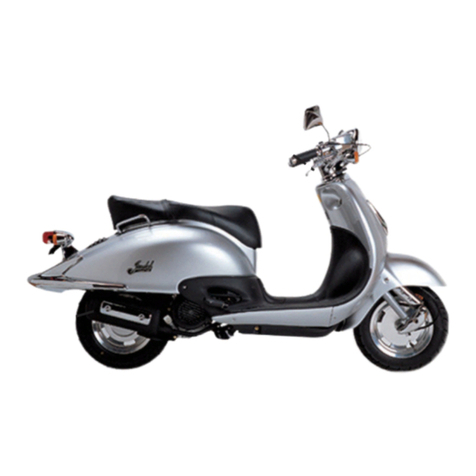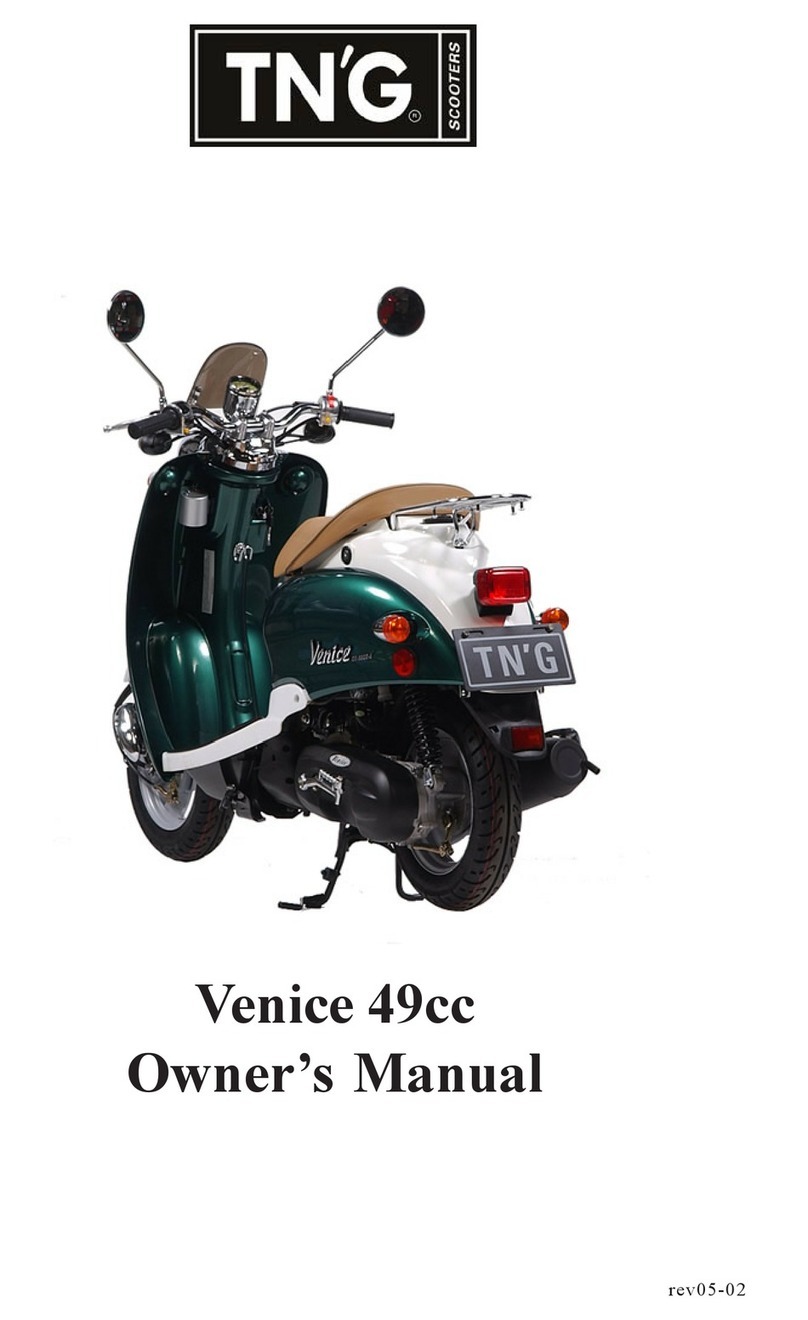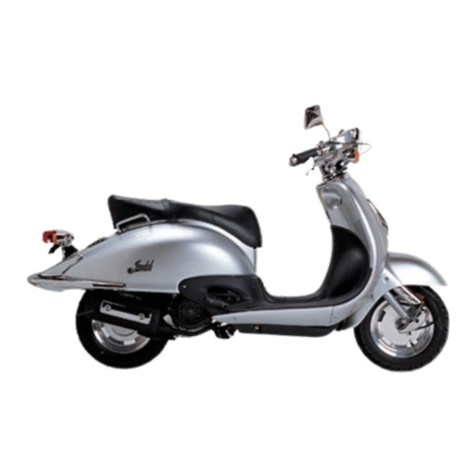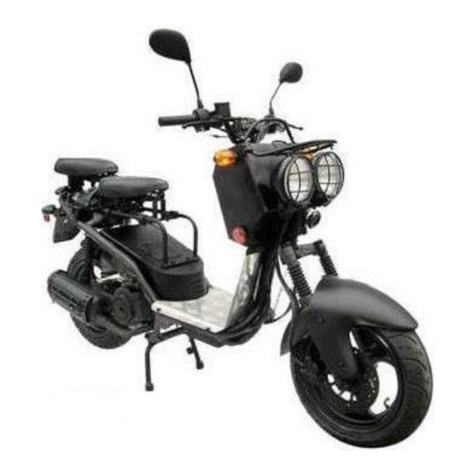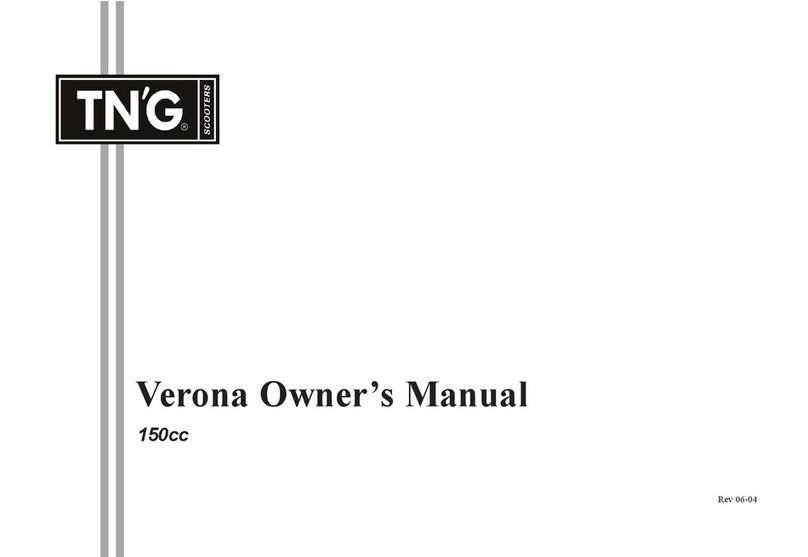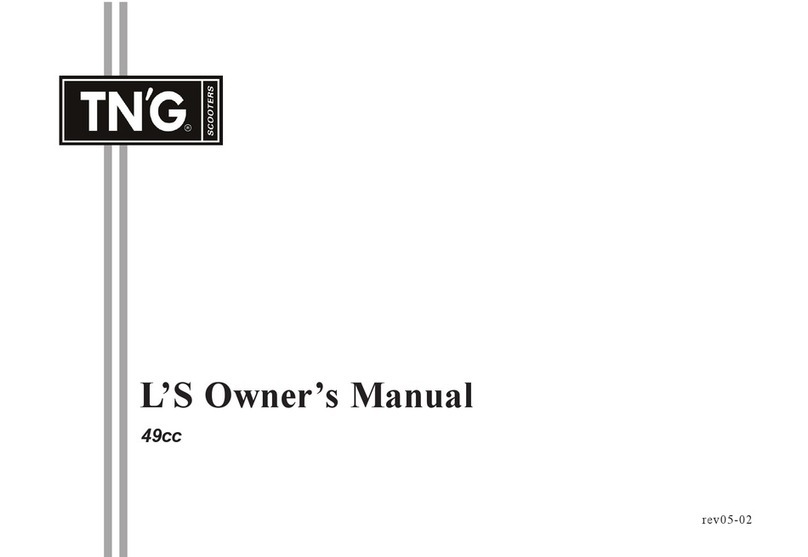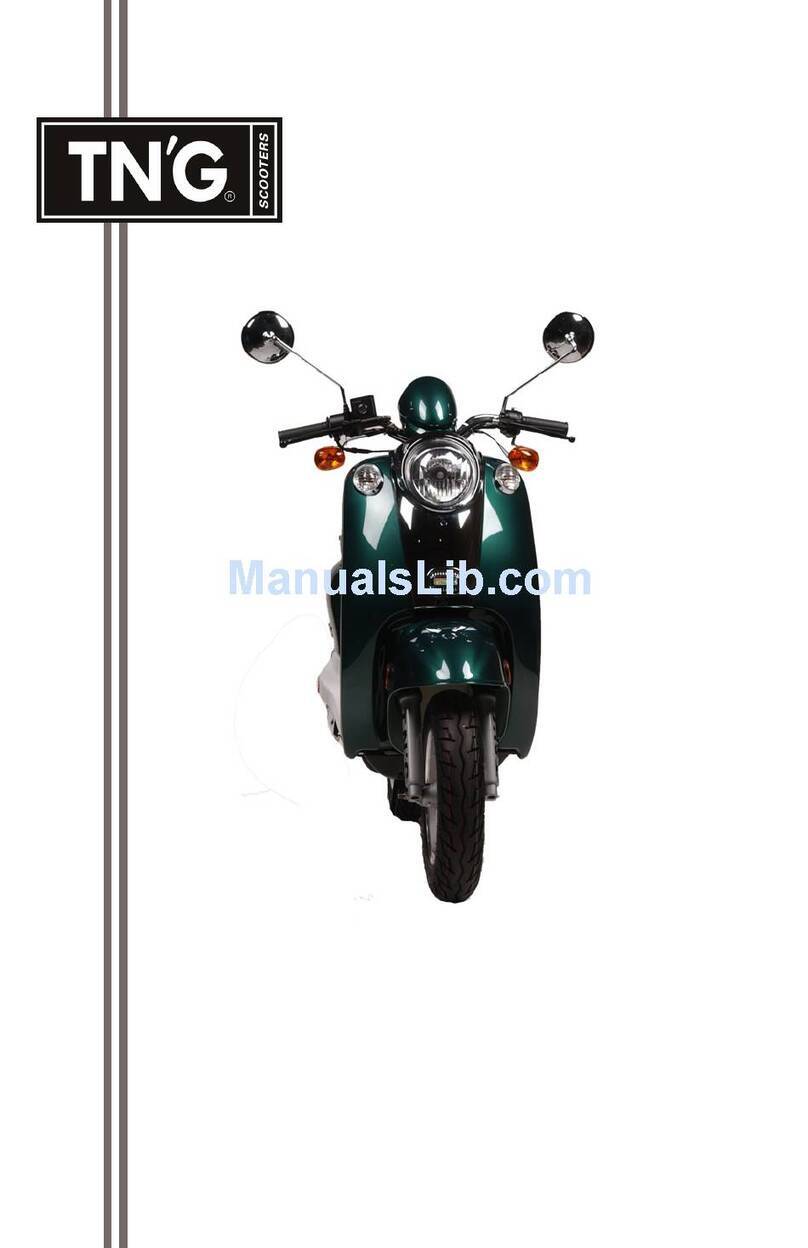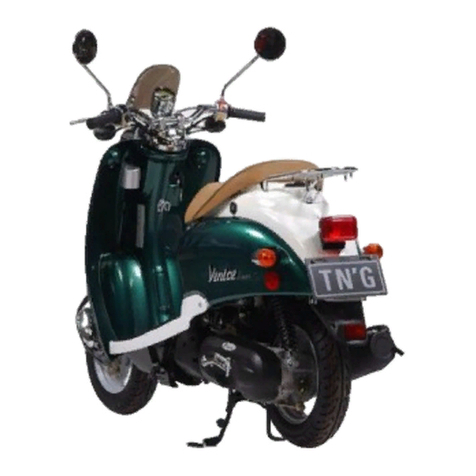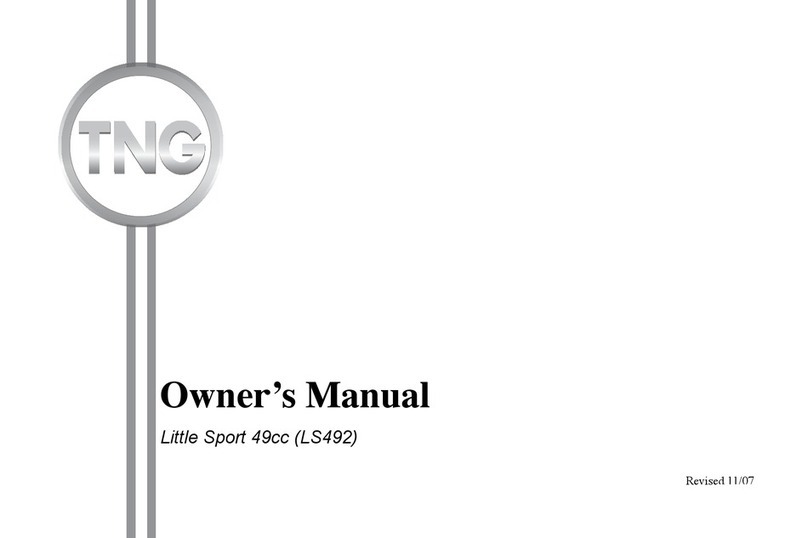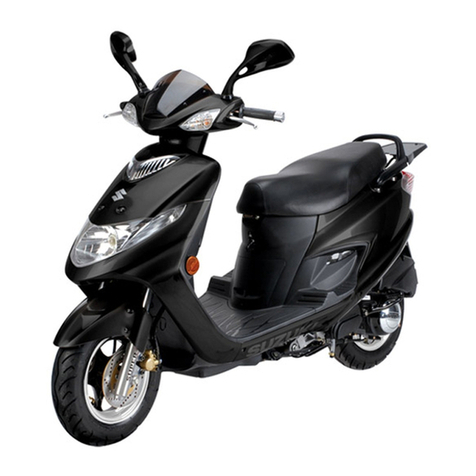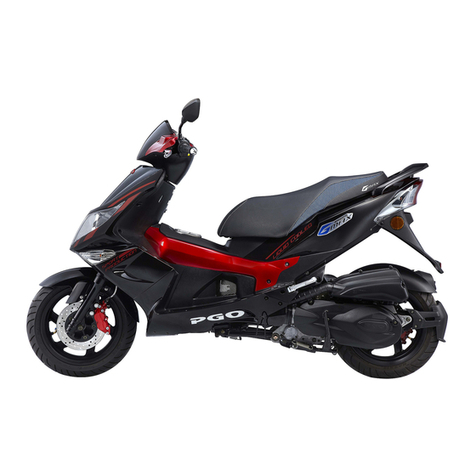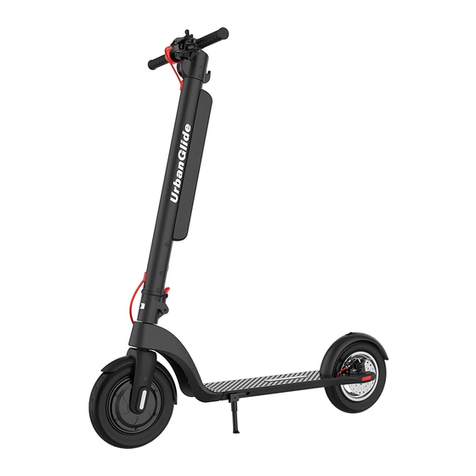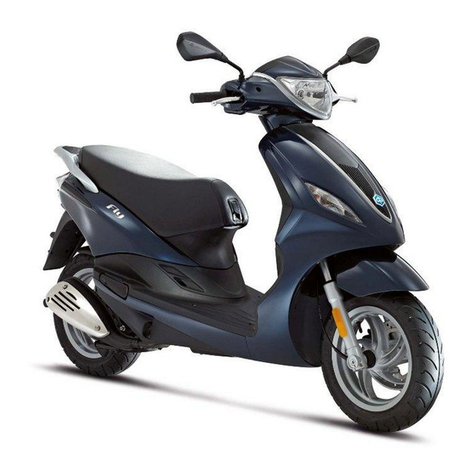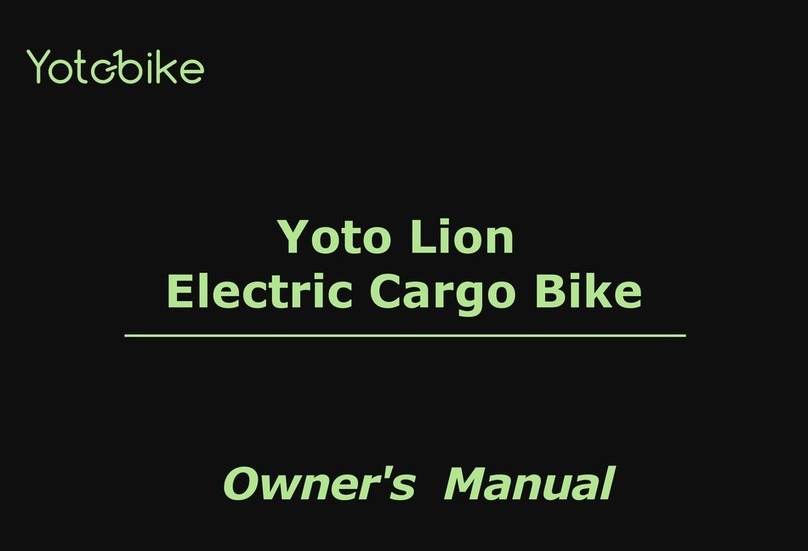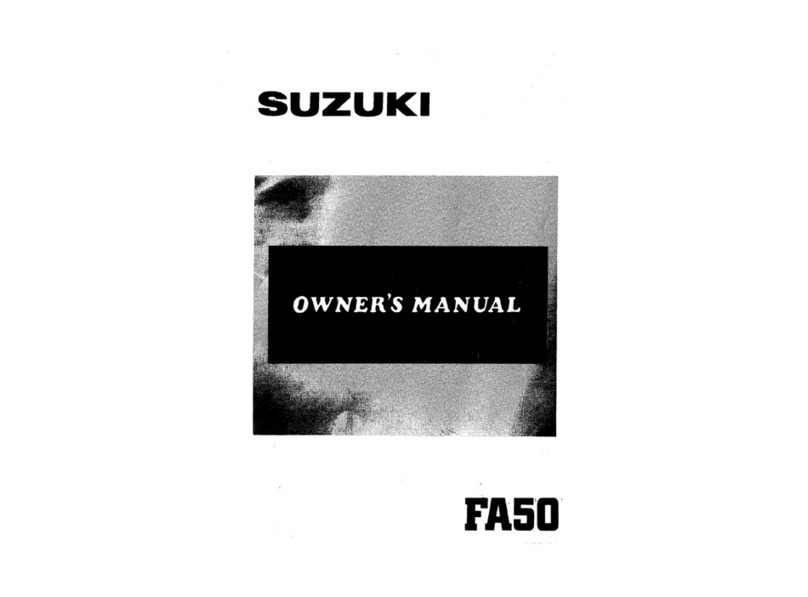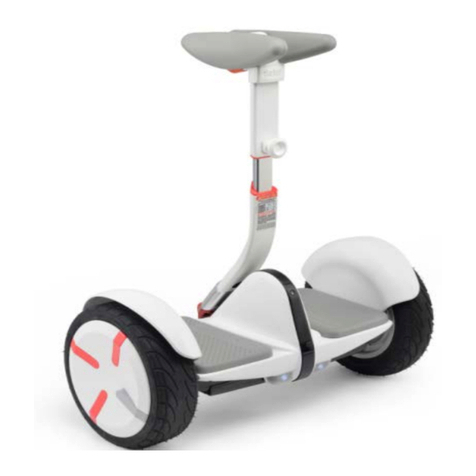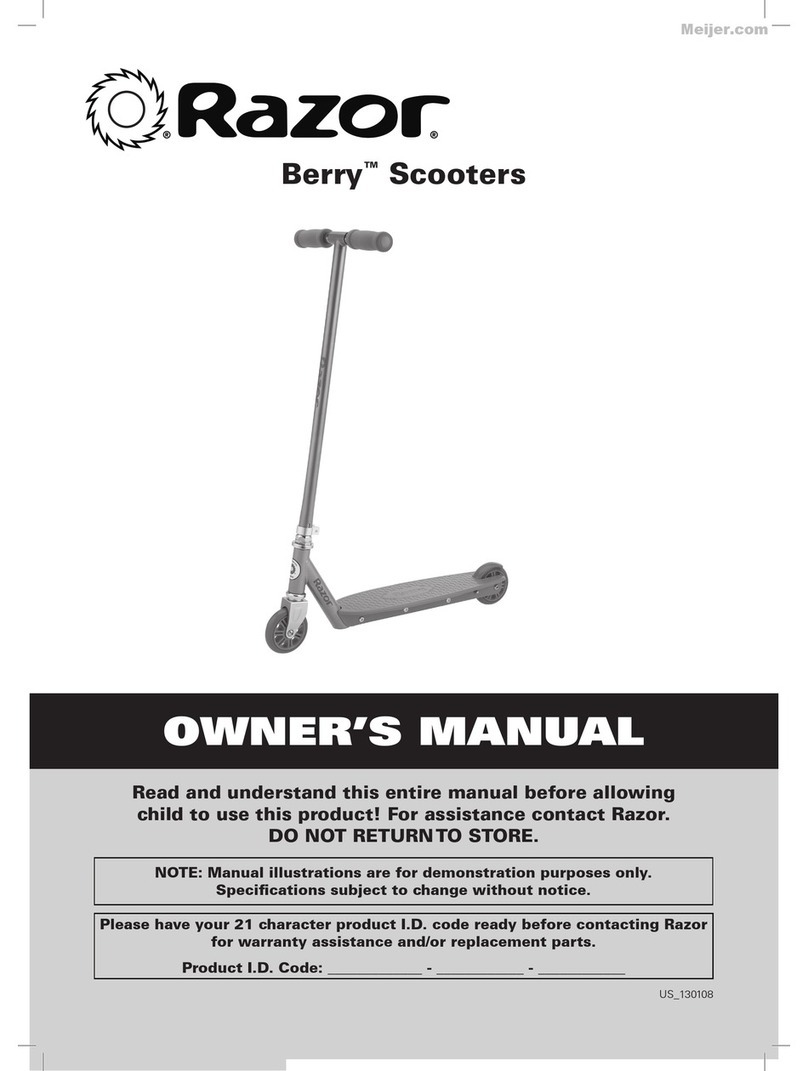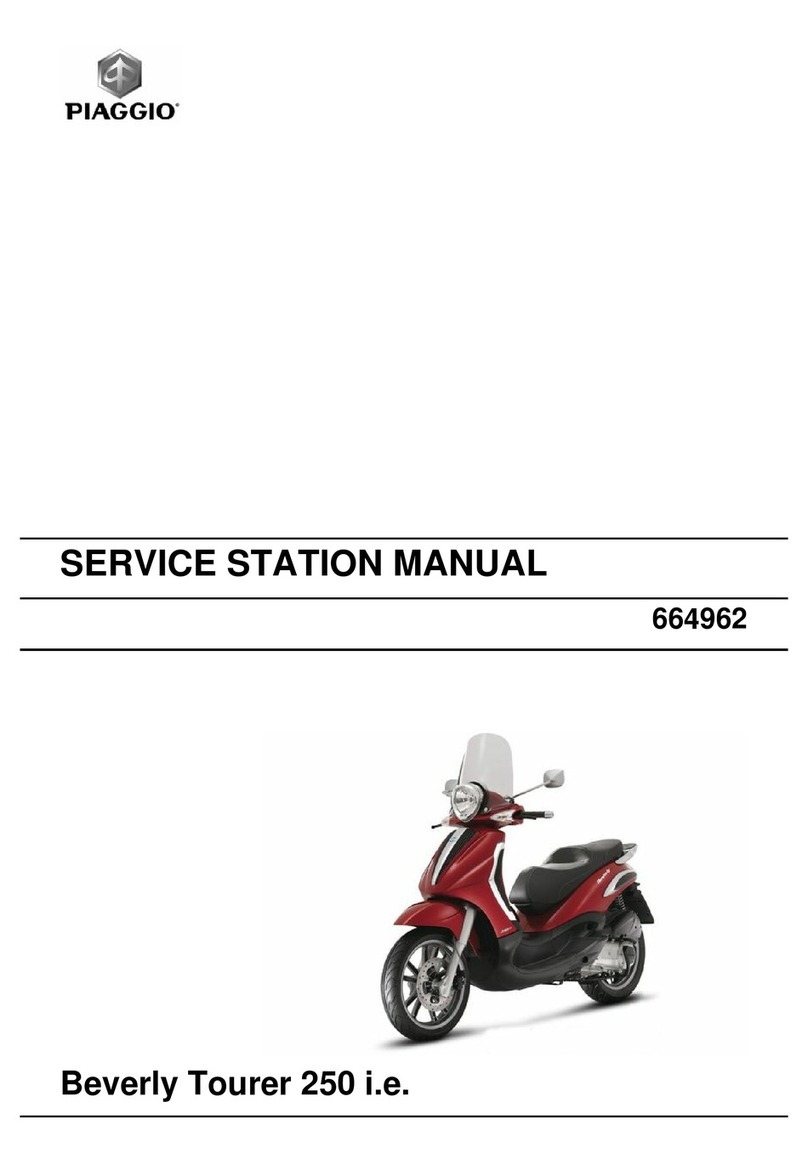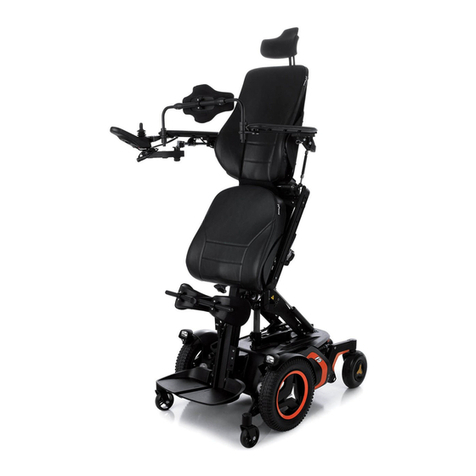TNG TN'G DR150cc User manual

DR150cc Owner’s Manual
Rev 2006-2

2
A: INTRODUCTION
Thank you for purchasing a CMSI Manufactured TN’G motor scooter. CMSI has invested
over 10 years in establishing the facilities, technical infrastructure and nationwide sales and
service network that exists today as TN’G Scooters, a trademark of CMSI. TN’G
Scooters is growing rapidly due to its reputation in quality research, styling & design,
production and service.
We recommend genuine TN’G products for replacement parts and accessories as they have
been specifically designed for your scooter and manufactured to meet CMSI demanding
standards. With the intention of achieving our goal to provide complete customer support,
detailed parts catalogs are available for you to view at our web site, www.tngscooters.com.
We continuously keep a large inventory of parts and accessories in stock to support our
TN’G dealers, service centers and ultimately, TN’G scooter owners. Your local TN’G
dealer knows your scooter the best and always is interested in your satisfaction! We advise
your local TNG dealer make all repairs on your scooter. You can find a complete list of
dealers and service centers on our website.

3
This Owner’s Manual contains important information on safety, operation, and maintenance.
Anyone who operates a TN’G Scooter should carefully read and understand the contents of this
manual before use.
TN’G Scooters are street legal vehicles in all 50 states. You need to check with your state
requirements on license and registration to ride this scooter legally on public roads.
SPECIAL SYMBOLS
Significant safety messages are provided both in this manual and on the scooter. For your safety
and the safety of others please pay special attention to all warnings preceded by !.
! WARNING - Indicates risk of severe injury or DEATH may result to the scooter operator, a
bystander or a person inspecting or repairing the scooter if failure to follow these instructions.
CAUTION - Indicates that special precaution must be taken to avoid damage to the scooter.
NOTE - A NOTE provides key information to make procedures easier to spot.

4
This Owner Manual should be considered as a permanent part of the scooter as it contains
important information for operation and maintenance of the scooter. It should remain with the
scooter at all times.
This Owner Manual contains the most current product information at the time of approval for
printing. TN’G Scooters reserves the right to make changes at any time without notice and
without incurring any obligation. If you have any questions about the manual, please consult
your TN’G dealers, or our web site www.tngscooters.com. The most recent documentation
will always be available on our web site.

5
B: TABLE OF CONTENTS
A: INTRODUCTION.............................................................................................Page 2
B: TABLE OF CONTENTS...................................................................................Page 5
C: SAFETY INSTRUCTIONS...............................................................................Page 6
D: SPECIFICATIONS............................................................................................Page 13
E: COMPONENT DESCRIPTIONS & FUNCTIONS...........................................Page 14
F: PRE-RIDE CHECKLIST...................................................................................Page 21
G: PROPER OPERATION....................................................................................Page 24
H: ROUTINE CHECKS & MAINTENANCE.......................................................Page 30
I: TROUBLESHOOTING......................................................................................Page 39
J: WARRANTY......................................................................................................Appendix

6
C: SAFETY INSTRUCTIONS
RIDING SCOOTERS IS FUN ONLY IF YOU PUT SAFETY AS YOUR TOP PRIORITY.
! WARNING:Before you start operating your scooter:
• Be sure you read this owner manual completely and understand all operating
features.
• Take sufficient time training with safe and proper riding technique.
• Practice until you are knowledgeable and comfortable with your scooter.
• Knowledgeable with all road signs.
! WARNING Failure to follow any SAFETY INSTRUCTION could cause severe injury
or even death to the scooter operator, passenger or a bystander.
Protective Gear
Riding a scooter leaves the rider exposed. Therefore, wearing appropriate protective gear
can prevent or diminish injuries from accidents.
1. An Approved Helmet
The majority of serious motorcycle injuries and deaths are the direct result of a head injury.
Therefore, drivers and passengers should always wear an approved helmet to prevent or
reduce the chance of head injury.

7
An approved helmet needs to:
•Meet U.S. Department of Transportation (DOT) and state standards. In addition
with labels from the Safety Helmet Council of America, theAmerican National
Standard Institute (ANSI), or the Snell Memorial Foundation to assure the integrity
of the product.
•Fits snugly on your head.
•Have no obvious defects such as cracks, loose padding or frayed straps.
2. Eye and Face Protection
•A plastic face shield can help prevent accidents by guarding the face from debris,
allowing the rider to devote full attention to the road.
•Goggles can protect your eyes in the same manner. Never use eyeglasses or
sunglasses in place a face shield or goggles.
3. Clothing
•Bright clothing should be worn by the driver so as to be easily seen by other
motorists.
•Jacket and pants should cover your arms and legs completely, but not too loose to
flap in the wind or catch on the levers or wheels which could result in an accident.

8
•Leather or heavy denim clothing is preferred as these materials help to prevent or
reduce abrasion.
•Boots or shoes should be high enough to cover your ankles and sturdy enough to
provide support.
•Gloves give you a better grip and help protect your hands from the elements.
Safe Riding
•Keep enough distance from the other vehicles around you as this gives you time to
react.
•Ensure that you have a driver’s license with correct classification to ride this scooter
in your state.
•Always observe the rules of the road. Observe the posted speed limit, and signal
your turns well in advance.
•Know your limits. Do not go faster then you are able to control. Always travel at a
speed that is proper for the terrain, operating conditions, and your experience.
•Always inspect your scooter each time you use it to make sure it is in safe operating
condition.
•Always follow the inspection and schedule maintenance procedures described in
this manual.

9
•Test your brakes after operation in wet conditions. If necessary, apply the brakes
several times to let friction dry out the linings.
•Never attempt wheelies, jumps and other stunts, as these could cause damage to
the scooter and loss of control.
•Always keep both hands on the handlebars and feet on the floor board during
operation.
•Never consume alcohol or drugs before or while riding scooter.
•Limit the travel distance to avoid fatigue that can affect your performance.
Being seen
Many scooter accidents are caused by car drivers who do not see scooter riders on the
road. Therefore you need to ensure to follow these guidelines:
•Wear bright clothing to increase visibility. Bright orange, yellow or green jackets or
vests and brightly colored helmet can help others see you.
•Always use turn signals when you are planning to turn or merge to main road and
turn it off after you have made your turn.
•Flash brake lights whenever you are going to slow down more quickly or where
others may not expect you are going to slow down.
•Stay out of blind spot of other motorists.
•When you come to an intersection, move to the portion of your lane that will bring
you into another driver’s field of sight at the earliest possible moment.

10
Carrying Passengers & Loading
! WARNING:
•This scooter is rated for 2 passengers; total weight of the rider and the
passenger must not exceed 330 lbs.
••
••
•Do not exceed 25 lbs of cargo.
••
••
•Any cargo should be kept in front compartment or under seat storage area.
You should avoid carrying passengers or large loads until you have gained sufficient
experience riding alone. Extra weight changes handling, stability, braking performance, turns,
acceleration and deceleration. To carry passengers safely you must:
1. Instruct the passenger before you start.
•Must wear a helmet.
•Get on the motorcycle after you have started the engine.
•Sit as far forward as possible without crowding the driver.
•Hold firmly to your waist, hips, or belt or passenger handle.
•Keep both feet on the pegs at all time, even when the motorcycle is stopped.
•Keep legs away from the muffler.
•Stay directly behind you, leaning as you lean.
•Avoid any unnecessary talking or motion.

11
2. Adjust your riding technique with passenger
•Go slower
•Start slowing earlier as you approach a stop.
•Maintain a larger cushion of space ahead and to the sides.
•Wait for larger gaps when you want to cross, enter, or merge with traffic.
3. Keep the load low and distribute the load evenly. An uneven load can cause the
motorcycle to drift to one side.
Gasoline & Exhaust Fumes
! WARNING Gasoline is highly flammable and exhaust fumes are poisonous:
•Turn off engine before refueling.
•not to spill any gasoline on the engine, exhaust system or the plastic body.
•Do not refuel while smoking or near any open flame.
•Do not operate your scooter in a closed area as the exhaust fumes may cause loss
of consciousness or death within a short time.
•Do not park the scooter near any flammable source.
•If you swallow gasoline, inhale gasoline vapor or spill gasoline into your eyes, see
doctor immediately or call AmericanAssociation of Poison Control Centers at 1-
800-222-1222 for assistance.

12
•If you spill gasoline on your clothes, change and wash the affected area immediately
with soap.
Modification
Any modifications to this scooter or removal of original equipment without approval from
TN’G Scooters may cause it to be unsafe for use and may trigger severe accident.
Modifications may also make your scooter illegal to use and will void any and all warranty
coverage.

13
Model Del Rey 150
Model Number DR150T-6
Length 76.7 inches
Width 25.5 inches
Height 44.5 inches
Dry Weight (No fuel) 253 lbs
Max. Load 330 lbs
Noise 80dB(A)
EngineType Air Cooled - 4 Stroke
CylinderArrangement Single Cylinder
Displacement 150cc
Ignition CDI
Transmission CVT
Front Brake Disc Anti-Lock
Rear Brake Drum
Tire Size (Front) 130/60 x13
Tire Size (Rear) 130/60 x13
Tire Pressure (Front) 32psi
Tire Pressure (Rear) 32psi
D: SPECIFICATIONS
Exhaust Vale Gap (Cold) 0.8 mm
Spark Plug Type NGKCR7HSA
Battery 12V 8Ah
Headlight 12V / 18W
Brake / Tail Light 12V21/5W
Turn Signal Lights 12V/10W
Fuses 15Amps
Fuel Type 90 Octane
Fuel Capacity 6 L / 1.6 gals
Lubricating Oil SAE 10 W30

14
E: COMPONENT DESCRIPTIONS & FUNCTIONS
1) Rear Carrier
2) Rear Light
3) Fuel Tank (under seat)
4) Seat
5) Throttle
6) Rear View Mirror
7) Brake Oil Resevoir
8) Front Box
9) Headlight
10) Exhaust Pipe
11) Drum Brake
12) Magneto
13) Passenger Footrest
14) Side Stand
15) Bag Hook
16) Disc Brake
17) Front Fender

15
1) Horn Switch
2) Rear Hand Brake
3) Rear View Left Mirror
4) lnstrument Panel
5) Rear View Right Mirror
6) Front Hand Brake
7) Throttle
8) Electrical Starter Switch
Controls and Instrument Panel
1) Turning Indicator
2) Odometer
3) Speedometer
4) High Beam Indicator
5) Fuel Level Indicator
6)Alarm Indicator
7) Digital Clock

16
Ignition Switch / Steering & Seat Lock
1. ON (starting): Engine can be started, electrical switches for horn,
lights, etc. can be activated, Keys can’t be removed
2. OFF (shutting down): Engine is deactivated, Lights, horn, etc. are
inoperable. Engine can’t be started. Keys can be removed
3.LOCK: Lights, horn, etc. can’t be used, Keys can be removed
CAUTION: If Ignition circuit (key or Remote) is ON when engine is not running will drain
battery and shorten battery life.
NOTE: Always turn” OFF” Remote Ignition and key Ignition when engine is not running.
! WARNING Do not change the key position while the scooter is in motion. It may result in
loss of control or an accident.

17
Left Handle
1. Horn Switch Press - the switch to sound the horn
2. Turn Signal Switch - Slide switch left to turn left, slide switch
right to turn right and push in the switch to discontinue.
3. Headlight Switch - High beam up position, low beam down
position.
4. Engine Kill Switch Turn into the “X” position to shut off.
Turn into the “O “ position to start the engine.
CAUTION: Be sure to always use LO BEAM light
when facing oncoming traffic.
Right Handle
1. Electrical Starter Switch Press electrical starter switch
for a maximum of 5 seconds. If engine does not start,
try again after a gap of 30 seconds
2. Lights Slide switch to left up to first level and quarter’s
position lights will come on, slide once more to next level
the head lights will come on.

18
Speedometer (See page 15) - Indicates the operating speed.
Odometer (See page 15)- Indicates accumulated distance.
Gas Gauge (see page 15) - Indicates the fuel Level. The needle moves towards “E” –
(empty) as the gas level is decreasing.
Throttle Control (see page 15)
•Control speed by rotating the throttle. (Right Grip)
•To accelerate speed, rotate the throttle towards you.
•To decelerate speed, rotate the throttle away from you.
Engine Stop Switch (see page 17) – Set the switch to on before starting the engine. Set the
switch to off for EMERGENCY STOP. For example, if the scooter overturns or you
cannot decrease speed with the throttle.
Rear Brake Lever/ Front Brake Lever (see page 15) - To apply rear brake, pull the left
lever towards the gradually. To apply the front brake, pull the right lever towards throttle
grip.

19
CAUTION:
•Do not store anything susceptible to heat inside storage compartments.
•Do not let humidity spread from storage compartment.
•Do not put anything valuable or breakable in storage compartment.
•The compartment is not waterproof. Use plastic bags to store stuff when washing
the scooter.
Luggage
! WARNING:
•Front Compartment - Do not exceed maximum 3 lbs for cargo.
•Under Seat - Do not exceed maximum 22 lbs for cargo.
Fuel Tank Cap (see page 14 for location)
•To remove the gas tank cap, lift the rear seat to expose the fuel cap. Turn the gas
cap ¼ counter-clockwise to remove.
•Fill the tank up to the bottom of the filler tube. Do not fill past that point.
•When finished filling gas tank, replace the gas cap ¼ clockwise to its locked
position. Swing seat down and make sure latch has engaged to lock the seat in
place.

20
! WARNING:
•Always turn the engine off prior to refueling the scooter.
•Ensure the fuel tank cap is properly installed before riding.
•Do not overfill the tank as it may overflow when the fuel warms up and expands.
•Avoid spilling fuel on a hot engine.
CAUTION:
•Wipe off the spilled fuel immediately as fuel may deteriorate the paint on the scooter or
any plastic parts.
•Always use 90 octane gasoline or higher when refueling the scooter.
Table of contents
Other TNG Scooter manuals


